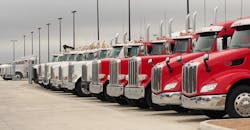With build slots scarce, Class 8 orders continue to slow
Class 8 tractor orders continue to be sluggish compared to last year’s boom, according to two research firms that track heavy-duty truck sales.
Demand is still strong, but supply is limited with all of the choice build slots for 2019 filled. Fleets that need trucks are basically taking whatever is available. Backlogs are rapidly declining, as the market tries to rebalance and establish some semblance of normality.
FTR reported this week that preliminary North American Class 8 orders for March was at 15,200 units, remaining below the 20,000 threshold for the third consecutive month. March 2019 was the lowest March for orders since 2010, according to FTR. March orders were 8% below February and down 67% year-over-year.
Class 8 orders for the past 12 months have now totaled 397,000 units, according to FTR.
ACT Research is tracking slightly higher numbers for March, showing the industry booked 15,700 Class 8 units in March. That is a 6.7% drop compared to ACT’s February numbers. The March numbers are still preliminary. ACT’s March numbers are down 66% year-over-year.
“March marks the fourth consecutive month of orders meaningfully below the current rate of build. Over that four-month period, Class 8 orders have been booked at a 194,000 SAAR, compared to a 489,000 SAAR for the same period a year ago,” said Steve Tam, ACT’s vice president.
“Even though demand is a shadow of its former self, slowing order intake belies current conditions,” Tam added. “Admittedly, economic and freight growth are slowing, but both are still growing. And in the context of retreat from record levels, it is no wonder truck buyers continue to pursue incremental profits, as evidenced by the number of unbuilt units in the backlog.”
Don Ake, FTR vice president of commercial vehicles, also noted these extraordinary market conditions. “Most fleets ordered well in advance of their need for trucks in 2019,” he said this week. “OEM production slots were scarce in 2018 and supplier constraints caused disruptions in supply, so fleets didn’t want to get shutout this year. Now so many build slots have been reserved, fleets that are currently placing orders for delivery this year don’t have many options.”
Although the economy and freight growth appear to be slowing, OEM line rates have not been impacted yet, Anke said. “Fleets are still putting more trucks in service and competing in a still decent freight market. It is expected that Class 8 sales will moderate sometime before the end of the year, as industry capacity begins to catch up with the freight surge that began in 2018.”
About the Author
Josh Fisher
Editor-in-Chief
Editor-in-Chief Josh Fisher has been with FleetOwner since 2017. He covers everything from modern fleet management to operational efficiency, artificial intelligence, autonomous trucking, alternative fuels and powertrains, regulations, and emerging transportation technology. Based in Maryland, he writes the Lane Shift Ahead column about the changing North American transportation landscape.

